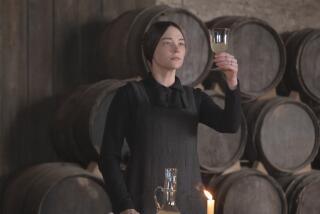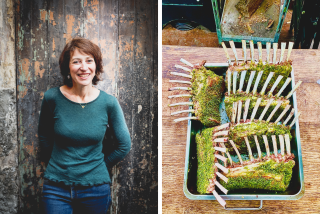The Importance of Being Franc
Years before I visited the Loire Valley, I used to round off the rough edges of transatlantic jet lag in a Paris wine bar over a couple of glasses of Chinon and an omelet or a baguette nicely slathered with rillettes. These âlittleâ Chinons were light reds, something like Beaujolais crossed with Bordeaux.
They may have been two-dimensional, but they were juicy and vibrantly fruity. There was enough charm and character there to suggest that Chinon might be able to produce much more serious wine. That possibility was enough to draw me to the region.
A perverse situation, this, being inspired to visit the Loire to find out more about its reds. The Loire Valley is a huge viticultural region, and from Muscadet in the west to Sancerre-Pouilly Fume in the east, most of it is devoted to the production of white wines.
But thereâs an area in west-central Loire, halfway between Tours and Angers, that specializes in reds. The major region is Chinon, together with its sister appellation north of the river, Bourgueil. (St. Nicolas de Bourgueil is part of the Bourgueil appellation but has its own legal designation as well.) Just to the west of them is Saumur-Champigny, a small triangular district behind the town of Saumur.
This is a particularly sweet landscape of soft skies and slow streams, of fairy-tale castles and ancient priories. Those romantic old buildings--and the regionâs ordinary homes, shops and bridges as well--were all made of the porous, cream-colored stone called tuff. Excavating it left vast caves, which were later converted into mushroom or wine cellars. The plateaus above them are prime vineyard land.
Cabernet Franc is the principal grape here. It ripens rather late--though earlier than Cabernet Sauvignon--and it resists rot well, which enables it to take advantage of the Loireâs Indian summers. Cabernet Franc is also cultivated in Bordeaux (particularly in St. Emilion), Italy, California and elsewhere, but the classic versions are made in the Loire. A vintner once observed that a grape achieves its noblest expression at the northern limits of its cultivation. For Cabernet Franc, thatâs the Loire.
Donât expect the âThus Spake Zarathustraâ of reds. Nature did not intend the Loire to make high-octane Cabernets. The wines are relatively low in alcohol, relatively high in acidity, with gentle tannins and concentrated berry and black cherry flavors, sometimes accented with a bell pepper note.
They have the brio and the tight focus of a string quartet; they may not be symphonic, but theyâre not soft and sluggish, either. Theyâre vital and sleek.
Part of the credit for these wines goes to the climate, but part is because vintners in this stretch of the Loire have simply put all their eggs in Cabernet Francâs basket. The best demand more of the grape than vintners in other regions, because they canât rely on plushy Merlot or strapping Cabernet Sauvignon to round out the flavor and texture, as winemakers in Bordeaux can, and they donât make a gamut of wines in which Cabernet Franc conveniently slips into the lower-priced red niche--as might be the case in, say, Sonoma.
If a Loire vintner wants to make a great red, heâs going to do it with Cabernet Franc or heâs not going to do it at all.
Loire Cabernet Francs come in three basic styles. The exuberant light reds I used to drink in Paris wine bars generally come from young vines or from grapes grown on the gravelly riverbanks. A heftier style, of moderate agreeability, is produced on siliceous slopes and plateaus. Wines from old vines or from well-exposed hillsides produce the richest, most complex and structured versions, which are capable of aging for as long as several decades.
Cool, long and silky, these top-rank Cabernet Francs have the effortless elegance characteristic of grapes grown on tuff. They pass from the vivid fruitiness of youth to a musky, visceral stage. Finally, after six or more years, they evolve toward a finespun fabric of sandalwood, spice, dried fruit and faded flowers.
How do you find serious Loire reds? As with any other wine region, look for wines from rigorous producers who seek low yields, harvest by hand and vinify carefully and thoughtfully.
Unfortunately, it isnât easy to find such wines in the U.S. Inevitably they come from producers who make no more than 5,000 cases a year apiece, and no major American distributor will carry them.
Check out small importers like Kermit Lynch, Fruit of the Vine, Louis Dressner or Associated Wine Distributors (Peter Weygandt) and ask for producers like Charles Joguet, Philippe Alliet or Bernard Baudry in Chinon; Pierre-Jacques Druet, Domaine de la Chevalerie or Yannick Amirault in Bourgueil; the Foucault brothers, Paul Filliatreau or the Cha^teau de Villeneuve in Saumur-Champigny.
Most of the above make at least two styles of wine; âYoung Vinesâ for immediate drinking (served slightly chilled) and âOld Vines,â which are single-vineyard bottlings intended for cellaring. (There is no legal definition of âOld Vines,â so you have to trust the vintner.)
Filliatreau, a relatively large Saumur-Champigny producer, caused a controversy in the â70s when he moved his winemaking out of the traditional cave cellars into cinder block structures and started keeping all his reds in stainless steel tanks to preserve their delectable fruit.
But he put Saumur-Champigny on the map; his succulent Champignys became the darlings of Paris restaurants because they were the perfect wines to serve with nouvelle cuisine.
The other recommended producers age their finest reds in barrels, often in once-used barriques purchased from top Bordeaux chateaus. The Foucault brothers, however, are creating a brouhaha by aging their best Saumur-Champigny in brand-new oak barrels, adding tannins and flavors in the toast and vanilla range. The Foucaults have among the lowest yields in the red wine zone of the Loire. Their riveting Champignys sell out to a rabid cult following of which a number of Franceâs leading wine mavens--and I--are members.
All wine politics is local. Suffice it to say that these different styles suggest endless possibilities of discovery and enjoyment. And when you get to this level of quality, the wines are all exciting and delicious.
Of course, these producers represent only a fraction of the Chinons, Bourgueils, etc., on the market. If you avoid negociant bottlings and stick with small producers, you can still find attractive, if less brilliant, versions.
Wines of such small producers often reveal another unique aspect of life in the central Loire: dolce far niente, French style. This is the land of Rabelais, and the prevalent philosophy is âeat, drink and be merry.â
The vast majority of vintners here make wine for their buddies and for impromptu revelry, not for Sotheby auctions or black-tie dinners. A grower who drops by his neighborâs cellar for a glass at 10 a.m. will not leave before lunch . . . and maybe not until 10 p.m., depending on the number of bottles opened, the vintages uncorked, who else happens by and the proximity of a snack.
Though inauspicious for production of the highest-quality wine, this deep-seated sociability is not without appeal. Most of these vintners have devoted clients who drive down from Paris year after year to buy the âhonestâ Chinon (or Bourgueil or Champigny) from their very own âhonestâ winemaker.
Itâs a delightful concept, and even confirmed wine cynics and the several muckrakers in the French wine press are seduced by the folklore of the honne^te vigneron.
And, to tell the truth, even when the workmanship is slipshod, or simply less than stellar, these red wines can be extremely tasty--perfect for Paris wine bar, Loire cellar or casual meal anywhere.
More to Read
Sign up for The Wild
Weâll help you find the best places to hike, bike and run, as well as the perfect silent spots for meditation and yoga.
You may occasionally receive promotional content from the Los Angeles Times.






